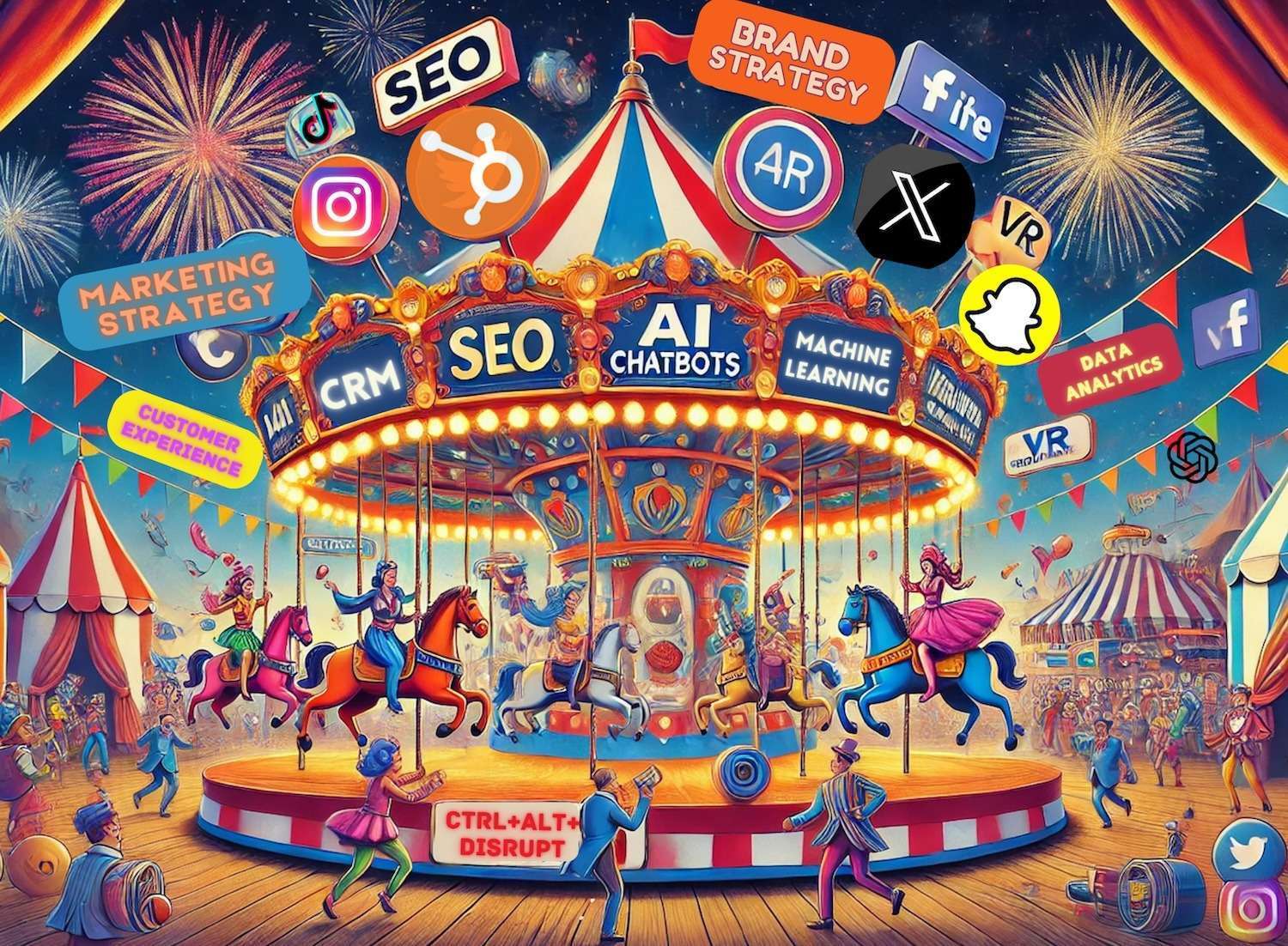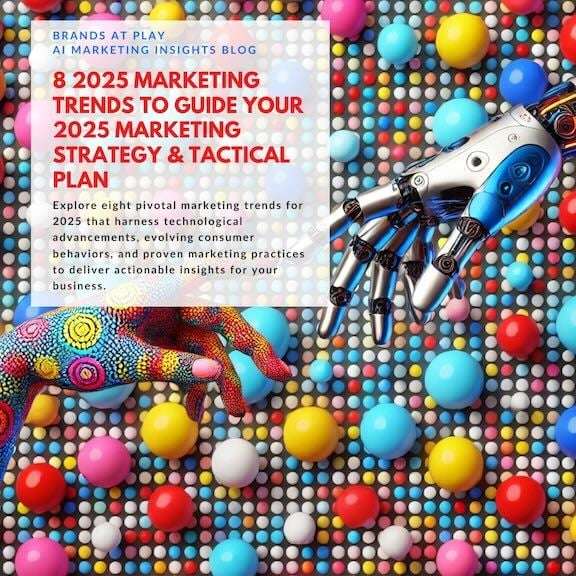Taylor Swift's Marketing Playbook: A Masterclass in Brand Strategy
From reluctant listener to stadium-filling superfan, my journey with Taylor Swift mirrors that of many professionals: I was initially drawn not to...
15 min read
Brands at Play : Mar 24, 2025 6:15:34 PM

 Table of Contents
Table of Contents
 1. Introduction: Why 2025 Branding Matters
1. Introduction: Why 2025 Branding MattersIn the world of corporate branding, staying ahead of the curve is crucial. By 2025, the global marketplace will be more crowded, diverse, and digitally connected than ever before. According to a 2023 Deloitte report, brand awareness and brand equity are increasingly critical as consumers have more choices across digital channels and social media accounts. These consumers are inundated with thousands of brand messages each day. To stand out, businesses need a holistic approach to brand development that captures attention, fosters an emotional connection, and drives a lasting impression.
The goal of this article is to provide best practices for developing a brand strategy that resonates in 2025. Whether you’re trying to attract new customers, expand your customer base, or simply maintain brand loyalty and customer loyalty with existing clients, having an effective branding strategy is a must. We will also cover how to create a strong brand identity, brand guidelines, a cohesive color palette, consistent visual elements, and a tone of voice that appeals to your target audience and target market. This article is written for marketing executives, business leaders, branding professionals, and small business owners looking to build or refine a successful brand.
For further reading on the fundamentals of what constitutes a brand, see the Wikipedia entry on Brand. For a deeper dive into the nuances of brand strategy, refer to Wikipedia’s page on Brand Management.
By 2025, the bulk of customer experience interactions will happen online. From search engine optimization (SEO) to hyper-personalized online content, brands must compete on digital platforms. Marketing campaigns will extend beyond just websites and blog posts; they will incorporate immersive experiences in augmented reality (AR), virtual reality (VR), and possibly the emerging Metaverse.
Modern consumers, especially millennials and Gen Z, place high value on brand values and social responsibility. A brand’s mission statement and core values must align with ethical and sustainable practices.
Consumers interact with brands across multiple touchpoints—from mobile apps to social media accounts, from email to physical retail experiences. Maintaining a consistent brand presence and delivering an emotional connection at each point of contact is non-negotiable.
Artificial Intelligence (AI) and machine learning will revolutionize branding efforts by powering predictive analytics, automated marketing campaigns, and real-time customer insights.
Seth Godin (see his Wikipedia page) has long championed storytelling as a cornerstone of effective branding strategy. By 2025, consumers will demand greater authenticity and transparency.
 3. Key Pillars of a 2025 Brand Strategy
3. Key Pillars of a 2025 Brand StrategyCrafting a brand strategy that aligns with 2025 realities requires a holistic approach. Below are the key elements every organization should consider.
A unique value proposition (UVP) succinctly answers why potential customers should choose your brand over competitors. According to Neil Patel (Wikipedia entry) and his marketing frameworks, a strong UVP highlights the specific benefits and brand promise your brand delivers.
Market research helps in understanding your audience’s preferences, pain points, and aspirations. Tools like Gartner’s marketing research frameworks, McKinsey consumer behavior studies, and HubSpot analytics platforms offer valuable data.
Your brand’s visual identity includes logo design, color palette, typography, and other design elements. A consistent brand identity is a unique identity that fosters brand recognition and builds trust.
Your tone of voice and brand message should resonate with your target audience. Consider:
Brand guidelines detail how to use brand elements like fonts, logos, and messaging across all platforms. This ensures that every customer touchpoint—from your company’s website to customer service to your blog posts—offers a consistent brand experience.
To turn potential customers into loyal brand advocates:
Branding is an ongoing process. Regularly update your brand assets and refine your brand strategy based on evolving consumer behavior, key performance indicators, and market trends.
 4. Branding Best Practices - Real-World Case Studies
4. Branding Best Practices - Real-World Case StudiesNo discussion of branding best practices is complete without case studies of companies that have successfully transformed or reinforced their brands. Below are a few great examples from both established industry giants and small business or emerging brands.
 5. Step-by-Step Brand Development and Implementation Process
5. Step-by-Step Brand Development and Implementation ProcessCreating a successful brand is a structured, ongoing process. Below is a comprehensive, step-by-step guide, inspired by frameworks from Simon Sinek (Wikipedia page), Seth Godin, Neil Patel, and the Brand Key Model from Prophet.
 6. Sample Branding Exercises and Free Templates
6. Sample Branding Exercises and Free TemplatesBelow are practical exercises and template frameworks inspired by top branding experts like Simon Sinek, Seth Godin, Neil Patel, and Gartner. Feel free to customize them to your brand’s values and industry.
Template Example:
WHY: We believe in empowering small businesses to thrive.
HOW: By providing cutting-edge marketing automation tools and personalized support.
WHAT: We offer a holistic suite of branding solutions that scale with our clients’ growth.
Reference: Simon Sinek on Wikipedia
Brand Key Model is a strategic framework widely used in corporate branding to clarify positioning.
Template Example:
1. Root Strength: Family-owned with a 50-year heritage.
2. Competitive Environment: Competes with global beverage giants.
3. Target Audience: Health-conscious millennials in urban areas.
4. Consumer Insight: They want authentic, organic drinks with minimal sugar.
5. Benefits: Natural energy, hydration, better taste.
6. Values and Personality: Friendly, transparent, eco-conscious.
7. Reason to Believe: 100% organic ingredients certified by USDA.
8. Discriminator: Locally sourced, small-batch brewing.
9. Brand Essence: “Pure refreshment for a conscious lifestyle.”
Reference: Prophet’s Brand Strategy Frameworks
Goal: Identify what makes your brand remarkable or worth talking about.
Reference: Seth Godin on Wikipedia
Template:
Tone of Voice = Friendly, Expert, Approachable
- Use short, clear sentences.
- Minimize jargon; if needed, define it.
- Prioritize inclusive language.
Example:
Primary Colors:
- Dark Blue (HEX #002F5F)
- White (HEX #FFFFFF)
- Light Gray (HEX #F5F5F5)
Secondary Colors:
- Bright Yellow (HEX #FFD600)
Typography:
- Headlines: Montserrat Bold
- Body: Open Sans Regular
Logo Usage:
- Maintain clear space equal to 50% of the logo’s height on all sides.
 7. Emerging Trends and Tools for Branding Efforts
7. Emerging Trends and Tools for Branding EffortsAs we look ahead to 2025 marketing strategies, several emerging trends and tools will help brands maintain a competitive edge:
 8. Measuring Key Performance Indicators and Success Metrics
8. Measuring Key Performance Indicators and Success MetricsTracking key performance indicators (KPIs) ensures your branding efforts deliver tangible results. Common KPIs include:
Use analytics platforms like Google Analytics, HubSpot, Marketo, or specialized brand tracking tools such as Brandwatch or Sprinklr to gather and analyze this data. Regularly review KPIs to refine your content marketing strategy, marketing campaigns, and overall brand strategy.
 9. Promoting Your Brand Strategy with Brands at Play
9. Promoting Your Brand Strategy with Brands at PlayFor businesses seeking professional assistance in crafting or refining their brand strategy, consider partnering with Brands at Play. Our holistic approach to brand development and marketing automation ensures that each client receives a custom solution tailored to their different goals—whether that’s attracting new customers, expanding into new markets, or solidifying brand loyalty.
Learn more about our specialized Brand Strategy services at Brands at Play – Brand Strategy.
 10. Conclusion: Building a Strong Brand Identity for 2025 and Beyond
10. Conclusion: Building a Strong Brand Identity for 2025 and BeyondAs 2025 approaches, the importance of a well-defined, effective branding strategy cannot be overstated. Brands must navigate an era defined by rapid technological advances, shifting consumer expectations, and a crowded global marketplace. By focusing on core values, brand positioning, consistent visual elements, a clear tone of voice, and data-driven personalization, you can create a strong brand identity that resonates with your target audience.
Remember, branding is an ongoing process—it evolves alongside consumer trends, societal shifts, and technological innovations. By continually revisiting your brand guidelines, refining your brand’s values, and monitoring key performance indicators, you ensure that your brand remains relevant, compelling, and profitable.
If you’re ready to take your branding efforts to the next level, consider partnering with a trusted expert like Brands at Play to build a comprehensive brand strategy. By doing so, you’ll not only create a lasting impression on your potential customers, but also secure a competitive edge in the dynamic marketplace of 2025 and beyond.
In 2025, successful branding best practices center on creating a consistent, personalized, and data-driven brand strategy. This includes developing a strong brand identity through cohesive visual elements such as logo design, color palettes, and typography; leveraging AI-driven analytics to tailor content across digital channels; and maintaining omnichannel consistency. Businesses should also focus on storytelling that resonates emotionally with their target audience, ensuring that each touchpoint—from social media accounts to company’s website—delivers a unified message. Additionally, employing a holistic approach that integrates market research, performance measurement, and continuous refinement is essential for capturing brand awareness and achieving sustainable growth.
A holistic approach to branding means considering every element of your brand’s visual identity, tone of voice, and customer interactions as interconnected parts of your overall brand strategy. By aligning your mission statement, core values, and unique value proposition with each aspect of your marketing efforts, you ensure a seamless customer experience. This integrated method boosts brand recognition because every component—from content marketing strategy to marketing campaigns—reinforces your brand’s message. Research from industry leaders such as McKinsey and Deloitte emphasizes that a unified, data-driven strategy can significantly enhance customer experience and brand loyalty, leading to increased market share.
Digital channels and social media accounts are at the forefront of modern branding best practices because they provide direct, real-time engagement with your target market. Platforms such as Instagram, LinkedIn, and Twitter allow brands to showcase their brand assets, share success stories through case studies, and communicate their brand values effectively. With integrated search engine optimization (SEO) techniques and personalized content strategies, businesses can improve their online content visibility and foster deeper connections with potential customers. Studies by Gartner indicate that consistent and targeted digital engagement can lead to higher conversion rates and improved customer retention.
Numerous case studies highlight the transformative impact of innovative branding best practices. For example, Nike leveraged its “Just Do It” campaign to boost its market share dramatically by aligning emotional storytelling with a consistent visual identity. Starbucks effectively used digital personalization and community engagement to grow its loyalty program to over 28 million members. Similarly, Apple has maintained a strong brand identity through minimalist design and a relentless focus on user experience, solidifying its status as a global powerhouse. Up-and-coming brands like Warby Parker have also disrupted their markets by combining affordability with distinctive brand positioning. These examples, backed by research from Harvard Business Review and McKinsey, underscore the value of integrated, data-driven branding strategies.
Brand guidelines and a consistent style guide are essential for maintaining uniformity across all marketing materials and digital channels. They establish clear rules for the use of logo design, color palette, typography, and imagery, ensuring that every touchpoint reflects the same brand personality. This consistency not only strengthens brand recognition but also builds trust among potential customers by delivering a cohesive and professional appearance. Leading brands often rely on these tools to enforce their brand messaging and tone of voice, creating a reliable brand identity that customers can instantly recognize and connect with.
Measuring the success of branding best practices requires tracking various key performance indicators (KPIs). Important metrics include brand awareness (using surveys and social media analytics), website traffic (bounce rate, session duration, and unique visitors), and conversion rates (lead generation and sales conversion). Additionally, monitoring customer satisfaction through Net Promoter Scores (NPS) and customer feedback is vital. Analytics from tools like Google Analytics, HubSpot, and Marketo provide actionable insights that help refine your brand strategy and adjust your marketing efforts to better resonate with your target audience.
AI-driven personalization and data analytics are transforming branding best practices by enabling brands to deliver highly targeted, relevant content to each customer base. Through machine learning algorithms, companies can analyze vast amounts of data from digital channels, social media, and customer interactions to create personalized experiences that align with the interests and behaviors of their target market. This not only increases customer satisfaction but also improves brand loyalty and drives higher conversion rates. Research from Harvard Business Review and Accenture shows that integrating AI into branding strategies can significantly enhance the customer journey and provide a measurable competitive advantage.
Small businesses can successfully implement branding best practices by focusing on strategies that build a solid brand identity and foster brand loyalty. Start with thorough market research to understand your target audience and identify your unique value proposition. Use free templates and industry frameworks to develop a consistent style guide and brand guidelines that reflect your core values and mission. Leverage digital channels and social media accounts to share authentic stories and engage with customers in real time. Additionally, monitor key performance indicators such as website traffic, conversion rates, and customer feedback to continually refine your brand strategy. By following these steps, small businesses can create a memorable brand presence that attracts new customers and steadily increases their market share.
For more information on how to elevate your brand strategy, visit Brands at Play or explore our dedicated Brand Strategy services at Brands at Play – Brand Strategy.

From reluctant listener to stadium-filling superfan, my journey with Taylor Swift mirrors that of many professionals: I was initially drawn not to...

The marketing landscape of 2025 demands a fundamental shift in how we approach brand strategy. Artificial intelligence (AI) is no longer a...
